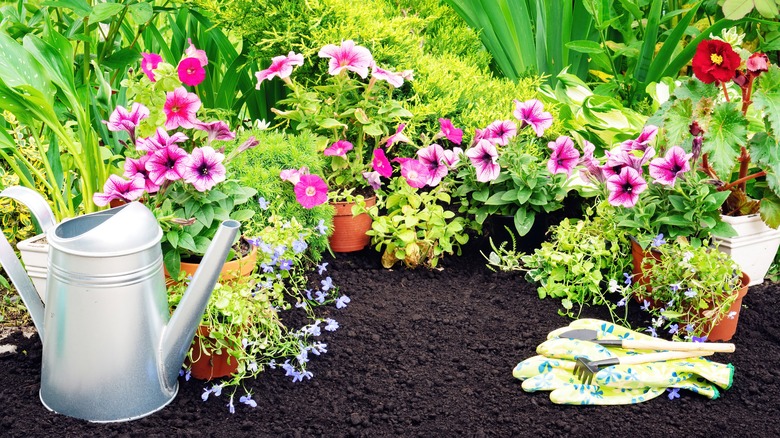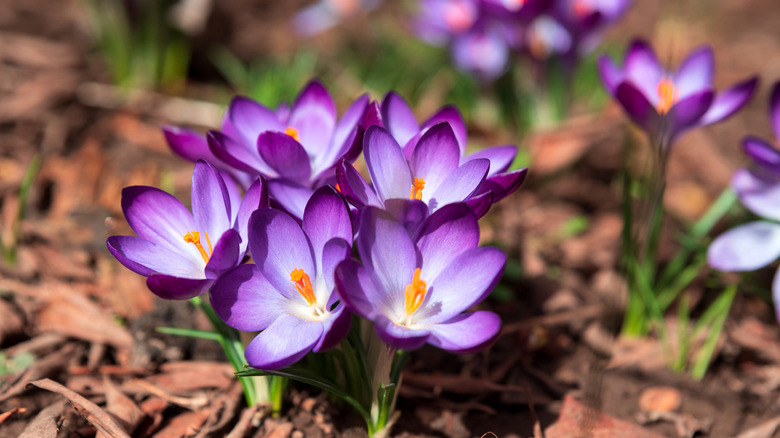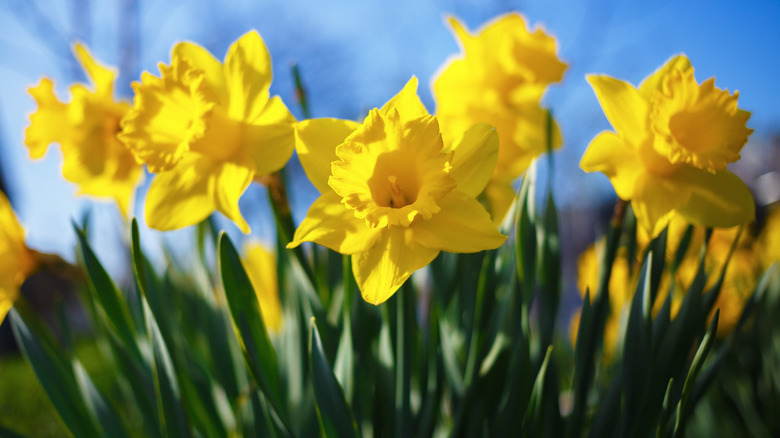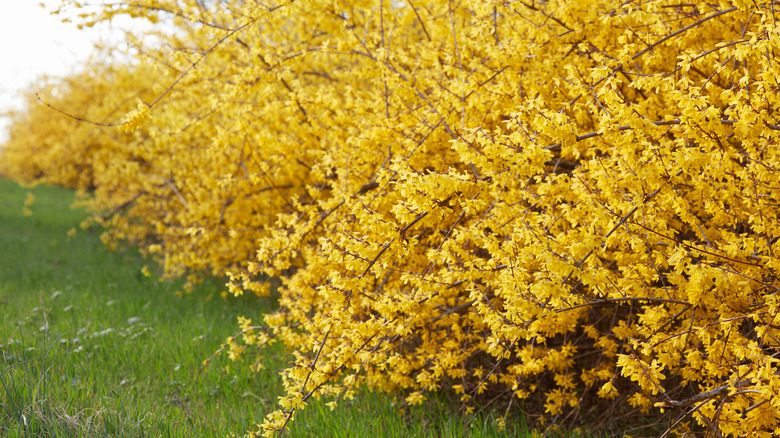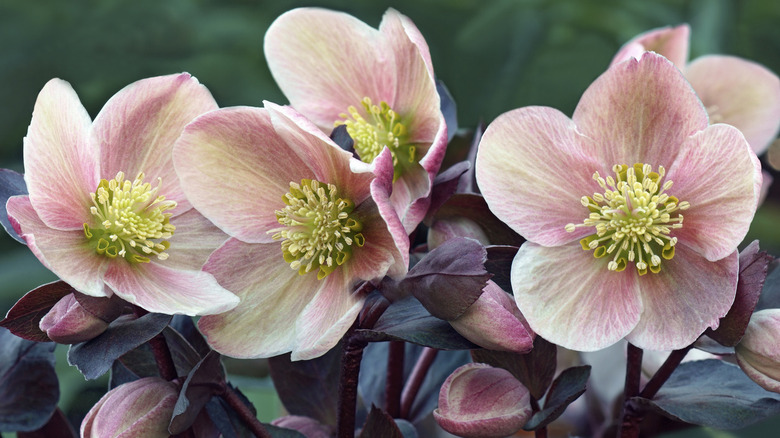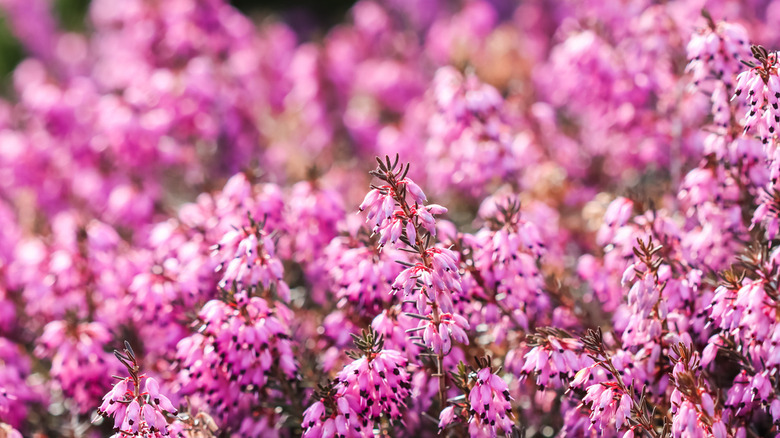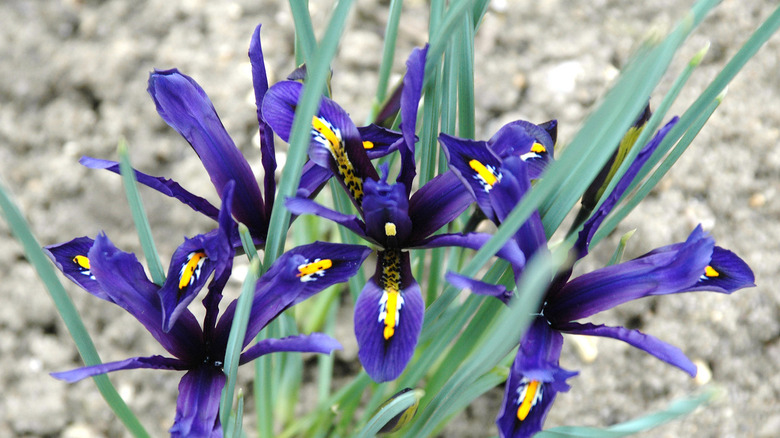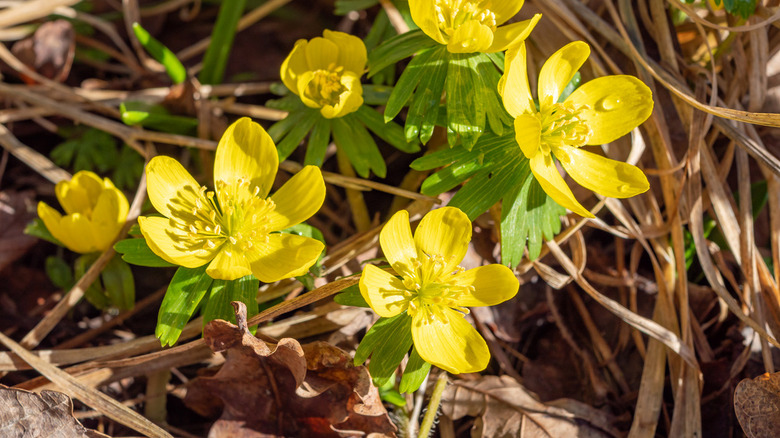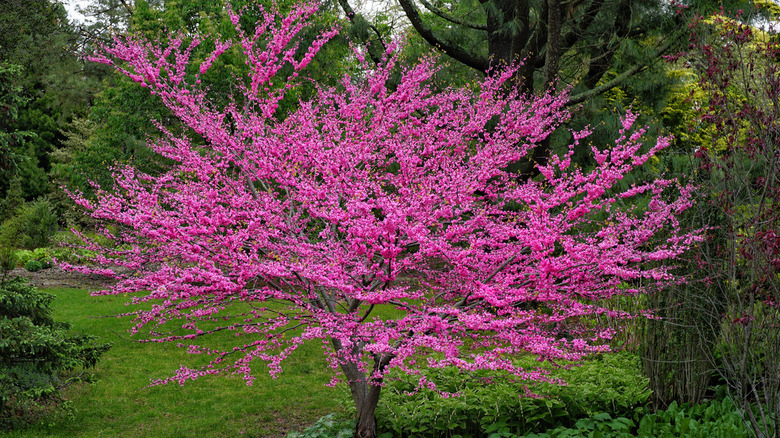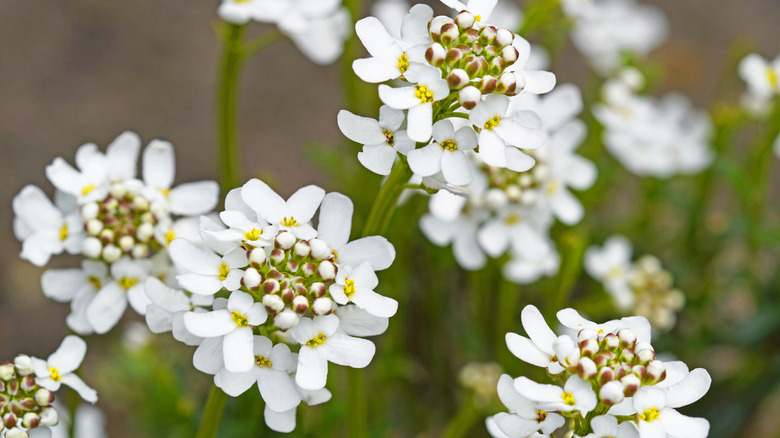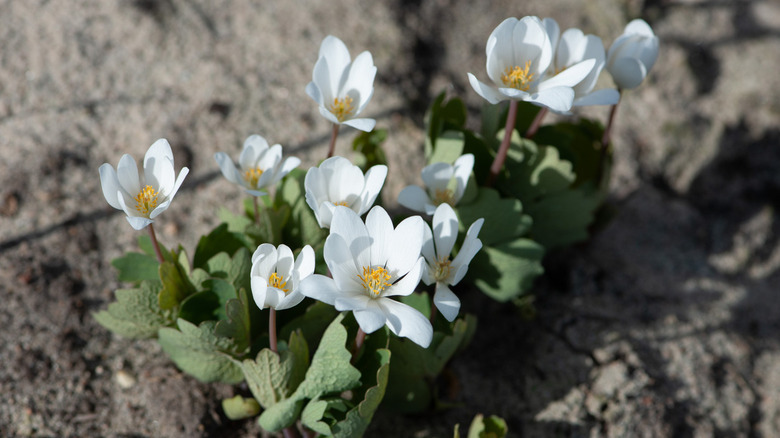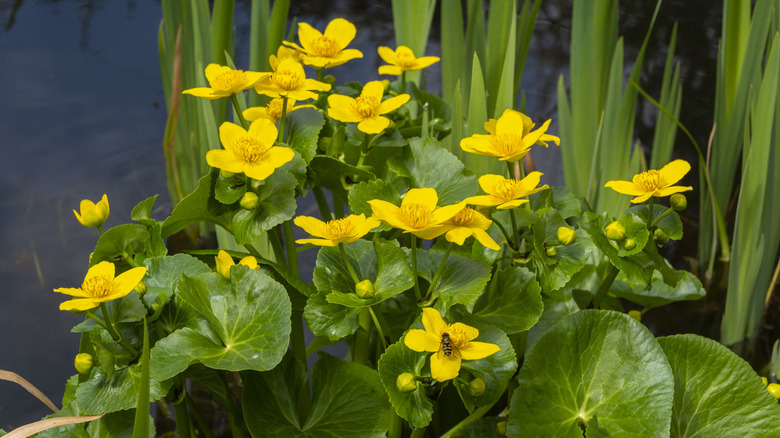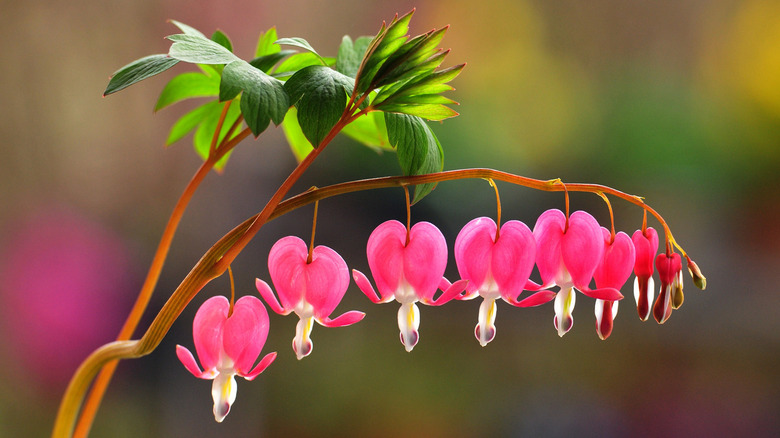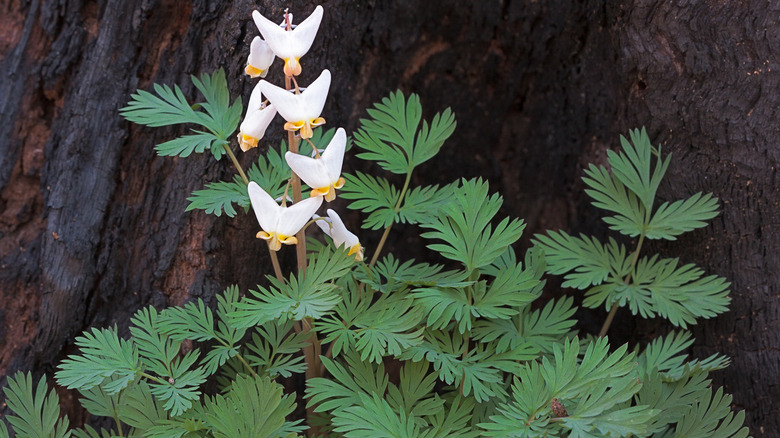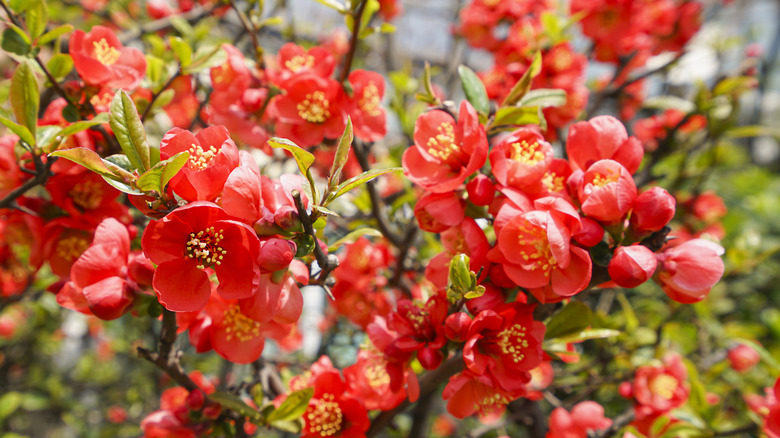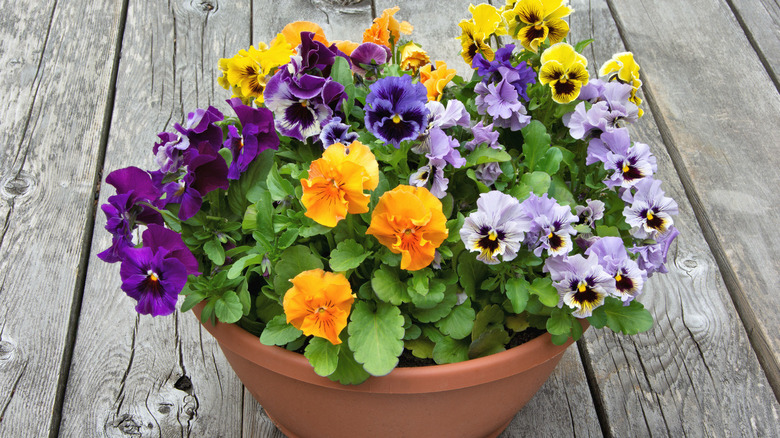15 Colorful Flowers That Will Bloom In Your Garden In Early Spring
What better way to usher in the fair weather than with several early spring blooming flowers? It goes without saying that the beginning of winter often marks the end of the growing season for many gardeners, according to the Weatherbug. The frigid winter temperatures are often not friendly enough for most plants except for the few winter bloomers. Flowers that bloom in early spring provide then much-needed color and vibrance way before other plants start emerging out of their winter dormancy.
When thinking of growing plants for early spring, proper preparation is necessary. You will need to begin planting as early as fall so that you are able to enjoy the spectacle from late winter to early spring (via Longfield Gardens). It is also worth mentioning that early-season bloomers often die back during summer. Therefore, if you want continuous interest in your yard, think about growing other flowers for all-season visual interest. Nonetheless, take some inspiration from the following flowers that bloom early in spring.
1. Crocus
Among the first blooms that you will see between late winter and early spring are from the Crocus (Crocus spp). In fact, it is not uncommon to find them peeking through the snow just before spring. The beauty of this plant is that the hybrid varieties bloom in different colors, for instance, yellow and orange (via Cornell University). To enjoy blooms during early spring, consider growing this plant during fall.
Bloom Season: Spring
USDA Growing Zone: 3-8
Growing Conditions: Full to partial sun
Soil Type: Well drained
Size: 6 inches tall and 1-3 inches wide
2. Daffodil
The bright yellow flowers of the daffodil (Narcissus spp.) are usually a much-welcomed sign of spring. While the popular flower color is yellow, daffodil plants also bloom in other colors like red and white depending on the variety, notes Cornell University. This particular plant is not only easy to grow but will also come back every year.
Bloom Season: Spring
USDA Growing Zone: 4-8
Growing Conditions: Full to partial sun
Soil Type: Rich well drained
Size: 6-30 inches tall and 6-12 inches wide
3. Forsythia
Forsythia (Forsythia spp.) is another good early spring blooming plant option that you can have in your yard. This deciduous shrub is easy to grow and can be pruned into beautiful screens or hedges (via the University of Minnesota Extension). One fascinating habit of this plant is that the flowers precede the foliage, allowing you to enjoy the yellow blooms for longer.
Bloom Season: Spring
USDA Growing Zone: 5-8
Growing Conditions: Full to partial sun
Soil Type: Moist well drained
Size: Up to 10 feet tall and wide
4. Lenten rose
The Lenten rose (Helleborus x hybridus) is not a real rose, but rather an evergreen flowering perennial of the buttercup family (via the University of Wisconsin-Madison Division of Extension). After a long harsh winter, this plant's blossoms are a good sign that the fair weather is here. Lenten rose blooms are famous for their early season emergence and color variety. Depending on the specific type, the flowers could be white or pink, among several other colors.
Bloom Season: Spring
USDA Growing Zone: 4-6
Growing Conditions: Partial sun
Soil Type: Moist well drained
Size: 12-18 inches tall and wide
5. Winter heath
The winter heath, better referred to as Erica carnea, is a low-growing shrub perfect as a ground cover. From late winter to early spring, this particular plant will grace your garden with beautiful purple-pink flowers in great abundance. The winter heath should definitely find a spot in your garden for providing color during the seasons you need it the most (via North Carolina State University Extension).
Bloom Season: Spring
USDA Growing Zone: 5-7
Growing Conditions: Full sun
Soil Type: Moist well drained
Size: 6-9 inches tall and 1-2 feet wide
6. Dwarf iris
Another great option for an early spring blooming plant is the dwarf iris, or Iris reticulata. This variety produces bluish to dark purple flowers with a signature golden center, mentions the University of Massachusetts Amherst. Other than the beautiful blooms, you will also love the sweet fragrance that comes with the flowers. They are relatively easy to care for and also promise to return every year.
Bloom Season: Spring
USDA Growing Zone: 5-9
Growing Conditions: Full to partial
Soil Type: Well drained
Size: 4-6 inches tall and up to 4 inches wide
7. Winter aconite
The winter aconite (Eranthis hyemalis) emerges while the snow is still on the ground and blooms very early into spring. This low-growing plant blooms in cup-shaped yellow flowers with a signature green bracket right underneath the flower. It is easy to grow and care for and best planted during fall, according to the University of Wisconsin-Madison Division of Extension.
Bloom Season: Spring
USDA Growing Zone: 3-7
Growing Conditions: Full to partial
Soil Type: Well drained
Size: Up to 6 inches tall and wide
8. Eastern redbud
If you are interested in a small deciduous tree that blooms early to mid-spring, then the eastern redbud (Cercis canadensis) is a good option. This small tree grows upright and rounded, forming a nice canopy. A mass of pink flower clusters emerges on the tree branches before the foliage begins growing back. The beauty of these trees is that they always have something to offer regardless of the season, mentions Michigan State University.
Bloom Season: Spring
USDA Growing Zone: 4-9
Growing Conditions: Full to partial
Soil Type: Rich well drained
Size: 20-30 feet tall and 25-35 feet wide
9. Candytuft
True to its name, candytuft (Iberis sempervirens) is a real treat and delight to the eyes. It is a low-growing plant that forms a nice carpet of white and pink blooms, perfect for an early-season garden. The brightly colored blooms contrast beautifully against the green foliage. According to Clemson Cooperative Extension, the candytuft flower is also ideal for a rock garden or xeriscaping.
Bloom Season: Spring
USDA Growing Zone: 3-9
Growing Conditions: Full to partial
Soil Type: Well drained
Size: 12-18 inches tall and 12-16 inches wide
10. Bloodroot
Bloodroot, also known as Sanguinaria canadensis, is a low-growing plant with short-lived blooms. Their presence always indicates the beginning of spring. Like most early-season bloomers, the bloodroot plant flowers way before the foliage start growing, mentions the University of Wisconsin-Madison Division of Extension. Although the white blooms with a yellow center don't last long, the sheer mass of flowers is a delight for as long as they last.
Bloom Season: Spring
USDA Growing Zone: 3-8
Growing Conditions: Partial shade
Soil Type: Well drained
Size: 5-12 inches tall and up to 10 inches wide
11. Marsh marigold
The marsh marigold (Caltha palustris) is not your typical plant. It loves wet areas, preferably near bonds or marshes. Despite the name, this plant is not a true marigold — it belongs to the buttercup family, as evidenced by the yellow flowers, as per the North Carolina State University. It is a rather low-maintenance plant and grows fairly fast, blooming in early spring. The flowers come back every year.
Bloom Season: Spring
USDA Growing Zone: 3-8
Growing Conditions: Full to partial sun
Soil Type: Moist to wet
Size: 1-2 feet tall and 12-18 inches wide
12. Bleeding heart
The bleeding heart plant (Lamprocapnos spectabilis) is an early spring bloomer popular for its heart-shaped flowers that delicately hang at the end of a long stem. The University of Arkansas Division of Agriculture mentions that this plant loves moisture and that the foliage dies back every winter. The bleeding heart grows fairly slowly, making it easy for you to control in your garden.
Bloom Season: Spring
USDA Growing Zone: 3-9
Growing Conditions: Partial shade
Soil Type: Moist well-drained soil
Size: 1-2 feet tall and 2-3 feet wide
13. Dutchman's breeches
Dutchman's breeches (Dicentra cucullaria) is a woodland wildflower that offers short-term, early-season interest to the garden. While the blooms only last for a short while, they are accompanied by a sweet fragrance every time they appear (via North Carolina State University Extension). To enjoy the white blooms early in spring, consider growing this plant in the fall.
Bloom Season: Spring
USDA Growing Zone: 3-7
Growing Conditions: Partial to full sun
Soil Type: Moist well-drained soil
Size: 6-12 inches tall and wide
14. Flowering quince
The flowering quince (Chaenomeles speciosa) might have a messy growing habit but will definitely compensate when it comes to beauty. Blossoms appear as early as late winter when there is snow and only fully emerge early in the spring. Other than the flowers, this particular plant is also popular because of its colorful foliage that only appears when the flowers die back (via The University of Arkansas Division of Agriculture).
Bloom Season: Spring
USDA Growing Zone: 5-9
Growing Conditions: Full sun
Soil Type: Moist well-drained soil
Size: 3-10 feet tall and wide
15. Pansy
Pansies (Viola x wittrockiana) are annual plants often used as short-lived perennials. They grow relatively fast and are popular for their colorful petals. They thrive in the cold and are ideal for providing color for early-season gardening. Because of the selective breeding, you can get pansies that bloom in different colors — for instance, yellow, red, and white, among several other colors, as per the University of Florida Gardening Solutions.
Bloom Season: Spring
USDA Growing Zone: 7-11
Growing Conditions: Full to partial sun
Soil Type: Well drained
Size: 4-8 inches tall and 4-6 inches wide
